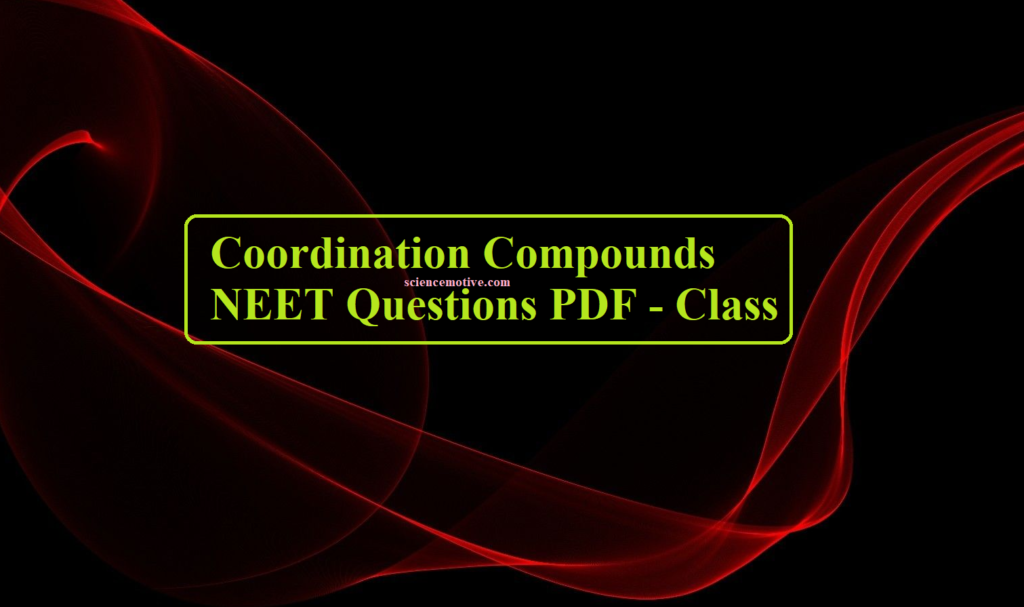Coordination Compounds NEET Questions PDF – Class 12 Chemistry
Coordination Compounds NEET Questions PDF
1. The bond between central metal ion and ligand in a complex compound.
a) Coordinate covalent
b) Covalent
c) Metallic
d) Ionic
Ans 1. a) Coordinate covalent
2. When 0.1 mol CoCl3(NH3)5 is combined with excess AgNO3, then 0.2 mol AgCl is obtained. The conductivity of the solution suits the
a) 1:3 electrolyte
b) 1:1 electrolyte
c) 3:1 electrolyte
d) 1:2 electrolyte
Ans 2: d) 1:2 electrolyte
3. The complex compounds which result from the coordination of carbon monoxide are known as
a) Electronic
b) Carbonyls
c) Carbonates
d) Carbon permonoxide
Ans 3: b) Carbonyls
4. The correct way of naming Co in [CoCl2(en)2]+is ________
a) cobalt(III)
b) cobalt(II)
c) cobaltate(III)
d) cobaltate(II)
Ans 4. a) cobalt(III)
5. Which of the following points are correct for primary valency?
a) It corresponds to an oxidation state
b) They are non-directional
c) lt is ionizable
d) All of these
Ans 5. a) It corresponds to an oxidation state
6. A chelating agent has two or more than two donor atoms to bind to a single metal ion. Which of the following is not a chelating agent?
a) Thiosulphato
b) Oxalato
c) Glycinato
d) Ethane-1,2-diamine
Ans 6: (a) Thiosulphato
7. In [Ni(NH3)4]SO4, the valency and coordination number of Ni will be respectively
a) 3 and 6
b) 2 and 4
c) 4 and 2
d) 4 and 4
Ans 7: b) 2 and 4
8. Which of the following is true regarding a charged coordination entity?
a) The charge is indicated as a subscript outside the square bracket on the right
b) The charge of the complexion is written in parenthesis while naming the entity
c) The sign of the charge is written after the number
d) The charge on the complexion is depicted along with the counter ion
Ans 8. c) The sign of the charge is written after the number
9. The number of ions formed by the complex K4[Fe(CN)6] is___________
a) Three
b) Four
c) Five
d) Six
Ans 9. c) Five
10. The type of isomerism shown by the complex [CoCl2(en)2] is
a) Geometrical isomerism
b) Coordination isomerism
c) Linkage isomerism
d) Ionization isomerism
Ans 10. a) Geometrical isomerism
11. Which of the following represents a chelating ligand?
a) H2O
b) OH−
c) DMG
d) Cl−
Ans 11. c) DMG
12. Which of the following terms is used to indicate the number of individual ligands that do not include a numerical prefix, in the name of a coordination compound?
a) tetra
b) bis
c) tris
d) tetrakis
Ans 12. a) tetra
13. Which of the following is not bidentate ligand?
a) Gly
b) C2O4-2
c) O2-
d) en
Ans 13. c) O2-
14. Which of the following elements do not form a complex with EDTA?
a) Ca
b) Mg
c) Be
d) Sr
Ans 14. c) Be
15. Identify the correct naming for K2[PdCl4].
a) Potassium tetrachlorinepalladium(II)
b) Potassium tetrachlorinepalladate(II)
c) Potassium tetrachloridopalladium(II)
d) Potassium tetrachloridopalladate(II)
Ans 15. d) Potassium tetrachloridopalladate(II)
Coordination Compounds NEET Questions PDF



